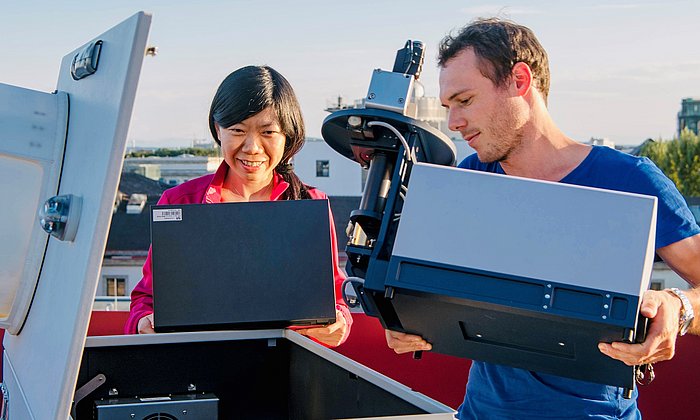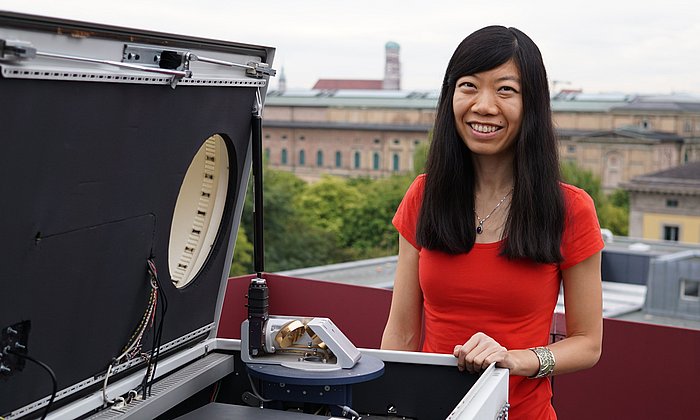Realistic calculation model compares climate friendliness of gas and electricity
Climate impact of natural gas often worse than assumed
![[Translate to English:]](/fileadmin/_processed_/4/f/csm_20170904_Chen_Jia_AH_355114_7a9eff7dd8.jpg)
“We wanted to know whether – when gas leakage is also considered – gas or electricity is more climate friendly for heating and cooking,” explains Dr. Florian Dietrich, a researcher at the TUM Associate Professorship of Environmental Sensing and Modeling. In collaboration with researchers at ETH Zurich, the University of Utrecht and the Dutch organization for applied research in natural sciences TNO, the international team used a high-tech measurement station to capture carbon dioxide, methane and carbon monoxide. They also used laser spectrometers for onsite methane measurements. They then combined all variables in a specially designed calculation model. The results were published and verified in a peer review process.
Incompletely burned natural gas an important factor in climate impact
At the 2019 Munich Oktoberfest, for example, the researchers observed that 1.4% of the gas used was lost. With a total volume of 185,000 cubic meters, this means that 2,500 cubic meters of unused gas was released into the atmosphere. “Our calculation model takes into account these amounts of escaped natural gas and provides a comprehensive emission factor for evaluating the use of natural gas for cooking and heating purposes,” explains Dr. Dietrich.
Renewable energy sources in the power mix reduce the emission factor
To determine whether natural gas or electricity is the more climate friendly option, however, the power mix is decisive: “A high share of renewables reduces the emission factor for electricity, while the use of electricity from such sources as coal-fired power stations has the opposite effect,” says Dr. Dietrich. By incorporating all of these factors into their calculation model, the researchers created a quantitative basis for identifying the countries where electricity is already a more climate-friendly choice than natural gas. They also concluded what the other countries need to do in order to arrive at this point.
For all 25 countries covered in the study, it is clear: “When we factor in leakage and incomplete combustion, a smaller share of renewable energy sources in the electric power mix is needed than previously assumed,” says Jia Chen, a professor of environmental sensing and monitoring, who is also the head of the Environment Innovation Sector at the TUM Robotics and AI Institute MIRMI. Consequently, it is possible for most countries to make the switch from gas to electricity at a much earlier stage.
Electricity clearly preferable in Canada
Looking at individual countries, that means that Canada, for example, with its high share of hydroelectric power, could already rely entirely on electricity for heating and cooking from a climate protection standpoint. In China the picture is different: due to the dominant role of coal in the power mix, electricity causes higher CO2 emissions than gas assuming identical energy output.
For Germany, despite the rapidly increasing share of wind and solar energy, electricity is not yet clearly better than gas. Germany has plenty of company in that respect: in 18 of the 25 countries evaluated in the study, including Spain, Italy, the Netherlands, Japan and Australia, electricity is not yet superior to gas in climate terms. However, a look at the TUM researchers’ graphs shows that electricity will soon be the more climate-friendly alternative for many of those countries due to the ongoing expansion of renewables.
Dietrich, F., Chen, J., Shekhar, A., Lober, S., Krämer, K., Leggett, G., Van der Veen, C., Velzeboer, I., Denier van der Gon, H., Röckmann, T. (2023). Climate impact comparison of electric and gas-powered end-user appliances. Earth's Future, 11, e2022EF002877. https://doi.org/10.1029/2022EF002877
- In a press tour on 27 June 2023 at the Automatica trade fair, from 11:30 to 12:30, representatives of the media will be able to see newly developed demos from the fields of health, mobility, environment and work - including a demo by Prof. Jia Chen. Accreditation via andreas.schmitz@tum.de.
- Technologies for this research project were provided by the environmental sensing and modeling research field of Prof. Jia Chen, the University of Utrecht and TNO, and the bioscience company LI-COR. They included:
- MUCCnet stations: The high-tech measurement station on the roof of the TUM research facility always showed a sharp rise in methane concentrations during the Oktoberfest. This prompted the scientists to take a closer look at methane emissions in combustion processes with natural gas.
- Laser spectroscopy: In addition to these measurements, Prof. Chen and Dr. Dietrich sent students to the Oktoberfest grounds with a laser spectrometer in a backpack. These precise onsite gas measurements confirmed the conjecture that an event like the Oktoberfest, where large amounts of energy are provided through natural gas, represents a large methane source.
- Through further measurements of isotopes and the ethane-methane ratio, the researchers were also able to determine exactly how much methane is released through leaks and incomplete combustion.
- Prof. Jia Chen is a professor of Environmental Sensing and Modeling at TUM and the head of the Environment Innovation Sector at the Munich Institute of Robotics and Machine Intelligence (MIRMI). With MIRMI, under Executive Director Prof. Sami Haddadin, TUM has created an integrative research center where over 70 TUM professors and their teams now work on new robotics and AI-based solutions in medicine, industrial production and nursing care. More information: https://www.mirmi.tum.de/.
Technical University of Munich
- Andreas Schmitz
- andreas.schmitz@tum.de
- 0162-27 46 193
Contacts to this article:
Prof. Jia Chen
Professur für Umweltsensorik und Modellierrung
Technische Universität München (TUM)
jia.chen@tum.de


